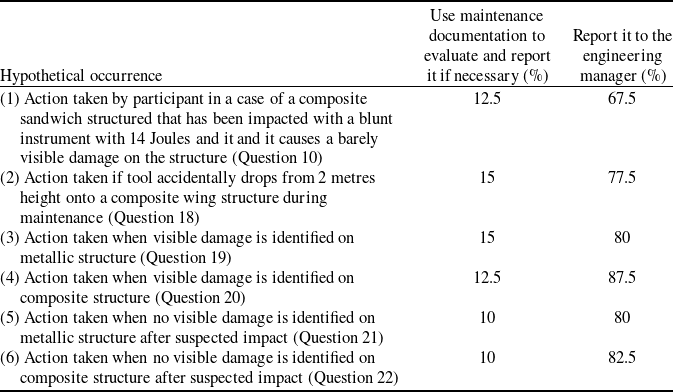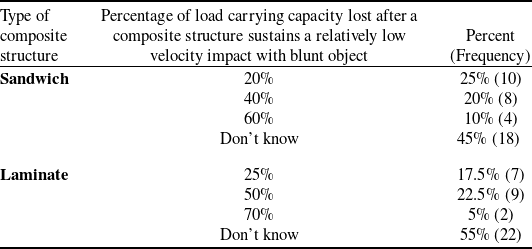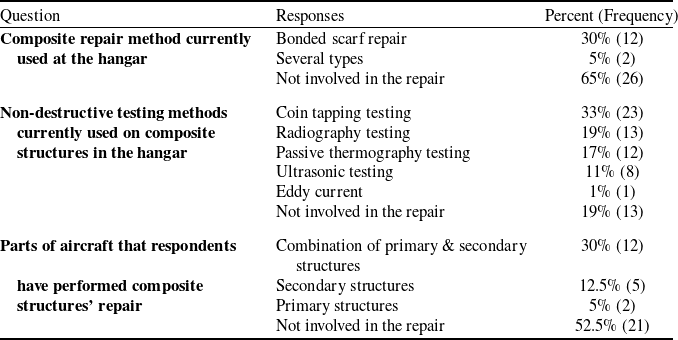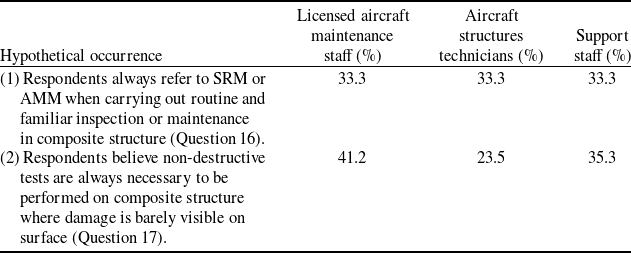Handling, inspection and repair of aircraft composites: a pilot study on the awareness of maintenance personnel; 2023; Journal article;
|
|
- English-United States (EN-US)
Composite materials are enjoying an increasing use in aircraft structures. As more fleets transition from metal to more composite aircraft, the practice of maintenance is also adjusting. Handling, inspection and repair of aircraft composites following non-visible or barely visible damage are among the areas of concern, due to associated cost and safety implications. A pilot study was performed to explore the level of awareness and understanding of aviation maintenance practitioners around these issues. In addition, this research project sought to identify factors related to the technical/engineering judgement capacity of the personnel working with composites and to gauge the need for specialised education and training. A questionnaire survey was administered to a group of 40 professionals working for an aircraft maintenance, repair and overhaul (MRO) organisation. Descriptive statistics in conjunction with analysis of variance (ANOVA) were used to analyse the results. The sources of impact and common areas affected on the aircraft have been identified, with situational awareness suggested as the most important mitigator against impact damage. Over 70% of the participants would refer to their engineering manager for instructions on how to handle composite damage. The need for higher standardisation for composites’ maintenance, repair and handling issues emerged as a common theme across different sections of the survey. Almost all respondents agree on the need for specialised knowledge and training for the handling, repair and inspection of composites.
|
| Pages ( - ) |
Aircraft composites, Aviation mainrtenance, Engineering, Knowledge Technologies, MRO, Training
Affordable and Clean Energy (7), Industry, Innovation and Infrastructure (9)
The application of composite materials (a synthesis of two or more materials with different mechanical properties) in aircraft structures has considerably expanded over the past decade, with the introduction of more lightweight passenger aircraft. For example, composites in primary and secondary structural parts of the Boeing 787 account for approximately 50% of the total airframe weight [1], as opposed to approximately 10% for the older generation Boeing 777 [2]. Nevertheless, composites exhibit modes of damage and failure which are not what typically observed in metals. Physical impacts at low velocity/energy can create defects on the composite materials which may promote the degradation of the integrity of the aircraft’s structure and, eventually, have the potential to lead to failures [Reference Dubinskii, Feygenbaum, Senik and Metelkin3]. That includes damage to the lightning protection layer. Impact loads may have a clearly or barely visible effect on the surface of the composite, but they can also be unnoticeable/undetectable via visual inspection, due to the subsurface nature of the induced damage [Reference Dubinskii, Senik and Feygenbaum4]. Classical subsurface damage resulting from a relatively low-energy out-of-plane impact event is dominated by matrix cracking which initiates under the point of impact spreading out in a pyramid pattern in the through thickness direction. Limited delamination may also occur between the layers. Key properties such as in-plane stiffness and in-plane compression strength are compromised due to this subsurface damage. Thus, such damage may be missed by the maintenance personnel when servicing the aircraft and when performing inspection and preventive maintenance to ensure its airworthiness condition. Understanding low-energy impact events is critical for damage tolerance of composite structures. The Garteur programme is an example of an early initiative to predict and characterise real impact damage in composite structures [Reference Falzon5]. Of course, state-of-the-art non-destructive test technologies such as ultrasonic scanning (A-scan, C-scan) and active thermography play a key role in reliably detecting and sizing damage in polymer composite laminates prior to material removal and repair being performed. Regarding repair strategies, there is still an ongoing need to understand the recovery of structural performance. Riccio et al. recently reported that the stacking sequence of the repair patch plays the main role in the effectiveness of recovering the mechanical performance and overall behaviour of the component [Reference Riccio, Sellitto, Garofano, Ingenito and Zarrelli6]. Overall, bonded flush repairs, i.e. scarf and stepped repairs, are very suitable for the repair of composite load-carrying structures as they provide maximum repair efficiency while keeping a smooth aerodynamic surface. Recent investigations on flush repairs focus on optimisation, durability and reliability. Beyond static behaviour, recent works were reported on damage-tolerant design for bonded repairs, along with fatigue and impact behaviour, that could raise the level of confidence associated with composite bonded repairs [Reference Orsatelli, Paroissien, Lachaud and Schwartz7]. Relatively new technologies such as additive manufacturing also have a role to play going forward. For example, the load bearing capacity of thermoplastic-based open hole laminates was significantly improved through the use of 3D printed patches [Reference Li, Liu, Wang and Zhao8]. The maintenance programmes for aircraft composite structures are still evolving to become more effective, to detect reliably potential defects, and more efficient, to facilitate productivity within the maintenance, repair and overhaul (MRO) service providers. In turn, MRO personnel are expected to understand the safety implications arising from poor handling, damage reporting and repair practices on composite structures [9]. Any limitations in knowledge around these safety-related matters, which might originate from limited awareness and/or insufficient training, can have a significant impact on the effectiveness of maintenance tasks [Reference Wang and Zimmermann10]. Moreover, the relatively short in-service experience with airframe composite materials and non-standardised repair techniques have been identified as safety concerns [9]. The maintenance workforce is predominantly accustomed to inspecting and repairing metallic aircraft structures, having less appreciation on the differences between composites and metals, especially in relation to non-visible or barely visible impact damage [9, Reference Baaran11, Reference Hobbs12]. The current literature surrounding safe handling, maintenance and repair of aircraft composites is heavily focused on the technical issues affecting the inspectability and maintainability of airframe structures [Reference Groves, Beaumont and Zweben13]. Only a few studies have examined safety under the prism of the aircraft maintenance practitioner, such as by Wang & Zimmermann [Reference Wang and Zimmermann10], and these are mostly limited to reports published more than a decade ago by government and aviation regulatory bodies, for example [9, Reference Baaran11, Reference Hobbs12]. However, there is a need for further research, due to the increasing introduction of aircraft types where the utilisation of composites is substantial (especially on large surfaces, such as the outer aircraft skin structure). The present pilot study intends to explore the level of awareness and understanding of aircraft MRO personnel around handling, inspection and repair of aircraft composite structures, as well as on damage reporting in the case of non-visible or barely visible impact damage. In addition, this research seeks to unveil issues related with the technical/engineering judgement capacity of the maintenance personnel working with composites and to explore the need for specialised education and training. To the best of the authors’ knowledge, this is the first research study attempting to shed a light on these important aspects, which have an effect not only on the safety of composites structures, but also on the productivity of maintenance staff within MRO organisations.
2.1 Instrument
The quantitative survey method was selected to address the objectives of this pilot study. The survey’s questionnaire consisted of 25 items, with multiple choice and open-ended questions used. Different types of questions were used in this questionnaire to: For this purpose, items were grouped accordingly to address these two objectives. The 25 items were then evaluated by an academic expert for the tool’s appropriateness. The questionnaire items, as they were formed after the expert evaluation process, can be found in the Appendix. Thematically, the questionnaire was divided in the following sections:
2.2 Sample
The questionnaire was administered to participants recruited from a single aircraft MRO facility. The questionnaire reached participants in online and paper-based formats for ease of access and to enhance participation. An ethics approval was obtained by the Faculty of Science and Engineering of the University of Limerick, with reference 2018_02_04_S&E ‘Potential issues for MRO’s (Maintenance, Repair, Overhaul Organisations) with the introduction of Composite Aircraft’. The process followed the ethics approval guidelines and participants’ confirmation, and anonymity was secured. A target population of 50 participants has been set, with 40 maintenance practitioners returning the questionnaire fully answered.
2.3 Data Analysis
The evaluation of the survey results relied on the principles of both descriptive statistics and inferential analysis. In particular, a correlational research design was employed to examine the relationship of the different groups of aviation practitioners and their views and attitudes towards the introduction of composite materials into maintenance and repair [Reference Fraenkel and Wallen14]. Following data screening to address any anomalies, the reliability of similar items was measured using the Cronbach’s alpha. This was followed by descriptive statistics and analysis of variance (ANOVA). All obtained data were quantitatively analysed using SPSS V28.
3.1 Questionnaire Section 1
Respondents were grouped into five different categories according to their job title (based on their responses to Question 2). Nearly half of them were licensed aircraft maintenance staff (45%) followed by the aircraft technicians and support staff who were marginally equal in size (25% and 23%, respectively), as illustrated in Fig. 1. The obtained data were screened to identify any anomalies and the reliability of similar constructs was measured using the Cronbach’s alpha. All these Cronbach’s alpha values ranged between 0.53 (for a two constructs comparison, which is acceptable for small numbers of items), 0.76 and 0.89. All results were deemed reliable and therefore acceptable for this research project. 
3.2 Questionnaire Section 2
When respondents were asked on the cause of impact on aircraft composite structures (Question 3), 65% of them gave the impact from ground support equipment as the most frequent one, followed by lightning strike (15%) and bird strike (8%) (Fig. 2). Furthermore, in their responses they detailed that the causes of impact are attributed primarily to cargo/catering/baggage load equipment (47%), passenger stairs/air bridges (39.5%) and aircraft servicing vehicles (11%). Figure 2. Respondents’ opinion on the most frequent cause of impact on aircraft composite structures. The areas most affected by impact damage in general, and those areas specifically affected during maintenance, were recorded in the responses of the participants to Questions 4 and 5 correspondingly. It is noted that, for standardisation purposes, the ATA Spec 100 classification [15] was used to identify the different zones of the aircraft. The obtained results, according to the percentile of participants for each area, are summarised graphically in Fig. 3. Figure 3. Schematic representation of percentile (%) participants’ responses on a) the aircraft structure that most of impact damage occurs (dark grey shaded boxes) and b) most vulnerable locations of an aircraft for damage to occur by impact in maintenance environment (light grey shaded boxes). (This figure has been designed using the airplane image by macrovector available on Freepick.com (https://www.freepik.com/free-vector/airplane-realistic-icons-set_3796055.htm)). The door area (ATA Zone 800) has been identified by the respondents as the most frequently affected by impact damage (57.5%), with the upper wing surface (ATA Zone 500 or 600) as the second most commonly referred response (17.5%). While, in terms of impact damage within a maintenance environment the responses were almost split evenly between the wing/flap area (ATA Zone 500 or 600) (35%) and the aircraft lower surface (ATA Zone 100) (35%), followed by elevator (ATA Zone 300) (19%). The results from Questions 6 and 7, on the type of objects/implements/objects likely to lead to impact events in/outside the hangar, are provided in Table 1. Ground support equipment has been considered by the respondents as the most frequent cause, with 55% of the total response received for in-hangar impacts and 65% for outside/on the ramp impacts. Maintenance tooling was the second more probable impact-originator for both cases, nevertheless for in-hangar impacts the responses accounted for 32.5% (as opposed to 15% for outside the hangar). A large difference was anticipated, given the more frequent and more extensive maintenance activity occurring within a hangar, as opposed to lighter maintenance performed outside the hangar (i.e. aircraft servicing and other flight line tasks). Also, foreign object debris (FOD) was not recorded in the responses for in-hangar impact events, while for the outside the hangar case it ranked as the third most probable (12.5%). Table 1. Participants’ answers on what tools/implements/objects are most likely to be involved in an impact event in the hangar and outside the hangar or on the ramp Two open-ended questions, Question 7 and 8, were used to record the participants’ views on mitigation measures against the risk of impact damage in and outside the hangar correspondingly. The obtained responses have been summarised and are presented in Table 2. Situational awareness has been highlighted as the most important mitigator, with 39% and 34% of the participants recording that in their responses, against impact damage occurrences inside and outside the hangar correspondingly. Re-evaluation of aircraft docking practice/procedures, protective mats/pads, training and facilities/resources were the other topics of importance reported. The responses for the in-hangar case were almost evenly split between these topics, with a distribution of 18%, 18%, 16% and 9%, correspondingly. Nevertheless, the outside the hangar results are heavily skewed towards training (28%) and facilities/resources (26%). This distribution may be reflective of the different operational environment outside hangar, both in terms of the nature and the tempo of the operations. Table 2. Participants’ answers on how they believe that the risk of impact damage can be reduced in the hangar and outside the hangar



3.3 Questionnaire Section 3
In this section of the questionnaire the respondents were requested to reflect on their immediate actions in six hypothetical occurrences during the performance of maintenance. Table 3 summarises their answers on whether they would report each one of the six incidents to their engineering manager or turn to the relevant maintenance documentation first. Across the six hypothetical scenarios, 10% to 15% of the respondents would use the relevant documentation to evaluate and report the incident, if necessary, while 67.5% to 87.5% would turn to the consultation of their engineering manager. This may be attributed to the less prescriptive character of maintenance documentation used for the assessment of structural damage of this type. However, this hypothesis needs to be further investigated, as the nature of the aviation maintenance profession and its practice within this, highly standardised, work environment requires the use of prescriptive documentation [Reference Zafiharimalala, Robin and Tricot16]. Access to aircraft type specific maintenance manuals would be required for this investigation. The lack of, or insufficient, instructions on damage assessment can have a negative impact on productivity, as implied by these responses. A higher-than-normal referral of damage cases to the engineering manager may create bottlenecks in the production. Table 3. Summary of immediate actions taken on six hypothetical occurrences To further evaluate these results, the Levene’s test was conducted for homogeneity. The obtained p values ranged between 0.63 and 0.75, which means that the one-way ANOVA assumptions have been met. However, the Shapiro Wilk’s test for normality failed to support the normal distribution of the study’s sample, and for this reason, an independent-samples Kruskall-Wallis test was selected. This test was used to investigate the differences of the three different groups of aviation practitioners in the way they would act in these six different scenarios of occurrences in their work practice (Table 3). The three groups are: licensed aircraft maintenance staff (N = 18), aircraft structures technicians (N = 10) and support staff (N = 9). It is noted that the groups of managers (N = 1) and aircraft training instructors (N = 2) were excluded from this analysis as they did not meet the minimum N requirement. The results indicated the differences in the mean scores of the groups’ answers across the three groups of practitioners to be statistically non-significant (p = 0.65). This means that there is 65% probability that these results occurred by random error. In this instance the null hypothesis is confirmed, therefore there is no true difference among the different groups of employees and their answers about their intentions in these different hypothetical occurrences into their practice (see Table 4, Fig. 4). Table 4. Means and standard deviations of actions on six hypothetical scenarios for the different groups of aviation practitioners Figure 4. Means of actions on six hypothetical scenarios for the three different groups of aviation practitioners. Extreme values represented with asterisk (*) and potential outliers with circle (○). Similarly, to compare the responses for nonvisible and visible damages in both composite and metallic structures, independent-samples’ Kruskall-Wallis tests were conducted. The results indicated no statistical significance in the different actions of the participants’ groups when the hypothetical scenarios included the nonvisible damages (p = 0.73). Again, no statistical significance in the different actions of the participants’ groups was identified when the hypothetical scenarios included the visible damages (p = 0.5). Thus, the results from the group of surveyed personnel cannot be generalised to a wider population. As described in Section 2.1, questions about the composite materials impact behaviour were included in this section of the questionnaire to investigate the level of knowledge of the participants around low velocity impact damage. The results from the two knowledge questions (Questions 11 and 12) are listed in Table 5. The key finding from these results is the high percentage of no responses (‘Don’t know’), accounting for approximately 50% of the participants. This indicates a lack of knowledge. Also, this percentage raises close to 60% when adding those participants who reported values outside the anticipated % of load carrying capacity lost after an impact damage on a sandwich composite (20%–40% loss) and a laminate composite (25%–50% loss). The results from the questions on the awareness and exposure of the respondents on repair and non-destructive inspections for composites (Questions 13, 14 and 15) are summarised in Table 6. While most of the participants responded that are not involved in the repair of composites, the results indicate that there is a general knowledge about the typical repairs and inspection techniques. However, the number of responses received between these three questions (Questions 13, 14 and 15) in the field ‘I am not involved in the repair of composite structures’ is inconsistent (Questions 26, 13 and 21 correspondingly). Therefore, these results cannot be analysed further. Next, the respondents were asked on the frequency of hypothetical actions on two (hypothetical) scenarios on composite structures’ maintenance and inspection (Questions 16 and 17). Table 7 presents the hypothetical scenarios and the results from the responses on the actions, namely ‘Yes, always”’ (ranging from 65% to 47%) and ‘Sometimes’ (ranging from 15% to 3%). Furthermore, the results were grouped and analysed according to personnel category (licensed aircraft maintenance staff, aircraft structures technicians and support staff), as presented in Table 8. Similarly, for the same groups, the means of actions during routine maintenance and repairs, are illustrated graphically in Fig. 5. Table 5. Respondents’ opinion on percentage of load carrying capacity lost after a composite sandwich and laminate structure sustains a relatively low velocity impact with a blunt object Table 6. Responses to questions on composite repair methods and non-destructive testing methods used in the hangar, and on which parts of the aircraft the respondents have performed composites’ repairs By conducting Levene’s test for homogeneity, the p values ranged between 0.86 and 1, which means that the one-way ANOVA assumptions have been met. However, the Shapiro Wilk’s test for normality failed to support the normal distribution of the study’s sample, and for this reason, an independent-samples Kruskall-Wallis test was selected as appropriate. This test was used to investigate the differences of the three different groups of aviation practitioners in the frequency of their responses to the two hypothetical maintenance and repair scenarios regarding composite structure (Table 7). The results indicated the differences in the mean scores of the groups’ answers across the three groups of practitioners to be statistically significant (p = 0.03). This means that there is 3% probability that these results occurred by random error. In this instance the null hypothesis is rejected, therefore there is true difference among the different groups of employees and their answers on the frequency of their actions regarding the two given hypothetical scenarios (Table 8, Fig. 5). Post hoc Tuckey HSD test were then conducted to identify the pairs of the three groups that appear to have statistically significant differences. These pairs are: •Licensed aircraft maintenance staff – support staff (p = 0.027, Hedge’s g = 1.03), indicating a large effect size and •Licensed aircraft maintenance staff – aircraft structures technicians (p = 0.053, Hedge’s g = 0.96), also indicating a large effect size. In Table 9 are presented the percentages of the three different groups of respondents that selected the ‘Yes, always’ answer at their two hypothetical actions on composite repairs and inspection. One can observe that the staff is evenly split or almost balanced for the two scenarios (approximately 30%–35%). The low percentage and the uniformity of responses across different categories of staff imply, again, that there may be a need for higher standardisation on composites’ maintenance, repair and handling issues (stemming from a possible lack of sufficiently prescriptive and detailed documentation) [Reference Armstrong17]. Table 7. Respondents’ answers on the frequency of their two hypothetical actions regarding composite structure Table 8. Means and standard deviations of respondents’ actions during routine maintenance and damage repair of composite structure for the different groups of aviation practitioners Table 9. Respondents’ answers on the “Yes, always” answer at their two hypothetical actions regarding composite structure Figure 5. Means of actions during routine maintenance and damage repair of composite structure for the different groups of aviation practitioners. Extreme values represented with asterisk (*).






The present pilot study has explored the views and experiences of maintenance staff working within a single aircraft MRO organisation. Despite the limitations of the sample size of the participants in the survey, this researched revealed a series of issues with an importance for safety and productivity. The primary findings and conclusions are summarised as following: Future work has been planned for this project, as soon as our collaborating MRO accumulates sufficient experience from composite repairs. Unfortunately, the low volume of work the industry has experienced over the past years, due to the pandemic, has no allowed MROs to gain this experience, which is necessary to expand our research project.
C. M. Jong: Conceptualisation, methodology, data curation, investigation, software, writing – review and editing. A. J. Comer: Conceptualisation, investigation, methodology, validation, project administration, writing – review and editing. A. V. Chatzi: Formal analysis, methodology, data curation, visualisation, validation, writing – original draft, review and editing. K. I. Kourousis: Data curation, visualisation, validation, writing – original draft, writing – review and editing.
The authors have no conflicts of interest to declare.
The Boeing 787 is manufactured using approximately 50% composite materials. The purpose of this survey is to identify potential issues with the introduction of this aircraft into a maintenance, repair and overhaul (MRO) facility with a particular focus on damage introduced by impact events. This survey requires 15 minutes. Section 1 1. I have read and signed the consent form associated with this study. 2. I am working as a: Section 2 3. What do you think is the most common cause of impact on aircraft composite structures? 4. Where in your experience does most of the impact damage occur on the aircraft structures?
Jong CM, Comer AJ, Chatzi AV, Kourousis KI. Handling, inspection and repair of aircraft composites: a pilot study on the awareness of maintenance personnel. The Aeronautical Journal. 2024;128(1320):211-229. https://doi.org/10.1017/aer.2023.28
[1] Boeing. 787 Dreamliner by design. 2022 [cited 2022 01 November 2022]; Available from: https://www.boeing.com/commercial/787/by-design/#/advanced-composite-use Google Scholar [2] Boeing. Boeing 777. 2022; Available from: https://www.boeing.com/commercial/777/#/design-highlights/technology/light-durable/ Google Scholar [3] Dubinskii, S., Feygenbaum, Y., Senik, V. and Metelkin, E. A study of accidental impact scenarios for composite wing damage tolerance evaluation. Aeronaut. J., 2019, 123, (1268), pp 1724–1739.CrossRefGoogle Scholar [4] Dubinskii, S., Senik, V. and Feygenbaum, Y. The significance of in-service factors for the visual detectability of impact damage in composite airframe. J. Nondestruct. Eval., 2019, 38, (4), p 91.CrossRefGoogle Scholar [5] Falzon, B.G. Impact damage and repair of composite structures. Aeronaut. J., 2016, 113, (1145), pp 431–445.CrossRefGoogle Scholar [6] Riccio, A., Sellitto, A., Garofano, A., Ingenito, G. and Zarrelli, M. Numerical-experimental study on the compressive behaviour of repaired composite panels. Compos. Part B: Eng., 2023, 251.CrossRefGoogle Scholar [7] Orsatelli, J.-B., Paroissien, E., Lachaud, F. and Schwartz, S. Bonded flush repairs for aerospace composite structures: A review on modelling strategies and application to repairs optimization, reliability and durability. Compos. Struct., 2023, 304.CrossRefGoogle Scholar [8] Li, L., Liu, W., Wang, Y. and Zhao, Z. Mechanical performance and damage monitoring of CFRP thermoplastic laminates with an open hole repaired by 3D printed patches. Compos. Struct., 2023, 303, p 116308.CrossRefGoogle Scholar [9] GAO U.G.A.O. GAO-11-849: Aviation safety: Status of FAA’s actions to oversee the safety of composite airplanes. 2011, United States Government Accountability Office (GAO), p 50.Google Scholar [10] Wang, P.H. and Zimmermann, N. Maintenance of composite-based aircraft components and structures through the perspective of aviation maintenance technicians in the United States. Coll. Aviat. Rev., 2021, 39, (2), pp 94–133.Google Scholar [11] Baaran, J. Final Report EASA-Research Project/2007/3: Study on visual inspection of composite structures. 2009, DLR Braunschweig, Institute of Composite Structures and Adaptive Systems, Lilienthalplatz 7, 38108 Braunschweig, Germany, p 114.Google Scholar [12] Hobbs, A. An overview of human factors in aviation maintenance. 2008, PO Box 967, Civic Square ACT 2608. p 47.Google Scholar [13] Groves, R.M. 3.12 inspection and monitoring of composite aircraft structures, in Comprehensive composite materials II, Beaumont, P.W.R. and Zweben, C.H., Editors. 2018, Oxford: Elsevier, pp 300–311.CrossRefGoogle Scholar [14] Fraenkel, J.R. and Wallen, N.E. How to design and evaluate research in education. Fifth edition. ed. 2003, Boston: McGraw-Hill Higher Education.Google Scholar [15] ATA. ATA specification 100: Specification for manufacturers technical data. 1999, Air Transport Association: Washington, DC: United States of America.Google Scholar [16] Zafiharimalala, H., Robin, D. and Tricot, A. Why aircraft maintenance technicians sometimes do not use their maintenance documents: Towards a new qualitative perspective. Int. J. Aviat. Psychol., 2014, 24, (3), pp 190–209.CrossRefGoogle Scholar [17] Armstrong, K.B. Efforts to standardize aerospace composite repairs, 1988–2003. Proc. Inst. Mech. Eng., Part G: J. Aerosp. Eng., 2003, 217, (5), pp 223–236.CrossRefGoogle Scholar [18] Derouen, C. and Kleiner, B.H. New developments in employee training. Work Study, 1994, 43, (2), pp 13–16.CrossRefGoogle Scholar [19] Garnier, C. et al. The detection of aeronautical defects in situ on composite structures using non destructive testing. Compos. Struct., 2011, 93, (5), pp 1328–1336.CrossRefGoogle Scholar Related content AI-generated results: by Impact on composite structures Type Article Title Impact on composite structures Authors Journal Published online: 3 February 2016 Energy absorption structures design of civil aircraft to improve crashworthiness Type Article Title Energy absorption structures design of civil aircraft to improve crashworthiness Authors Journal Published online: 27 January 2016 The perforation resistance of sandwich structures subjected to low velocity projectile impact loading Type Article Title Authors J. Zhou , Z. W. Guan and W. J. Cantwell Journal Published online: 27 January 2016 Aircraft structures Type Article Title Authors Journal Published online: 4 July 2016 Evolving fuselage designs by incorporating SHM technologies Type Article Title Evolving fuselage designs by incorporating SHM technologies Authors Journal Published online: 27 January 2016 Aspects of battle damage repair of helicopter structures Type Article Title Aspects of battle damage repair of helicopter structures Authors Journal Published online: 3 February 2016 Characterisation of the realistic impact threat from runway debris Type Article Title Characterisation of the realistic impact threat from runway debris Authors E. S. Greenhalgh , G. A. F. Chichester , A. Mew , M. Slade and R. Bowen Journal Published online: 4 July 2016 Composite materials, composite structures, composite systems Type Article Title Composite materials, composite structures, composite systems Authors M. van Tooren , C. Kasapoglou and H. Bersee Journal Published online: 27 January 2016 Aircraft structures in the century ahead: From arts to science, from craftsmanship to multidisciplinary design and engineering Type Article Title Authors A. Beukers , M. van Tooren and C. Vermeeren Journal Published online: 4 July 2016 Manufacturing technology development for aerospace composite structures

